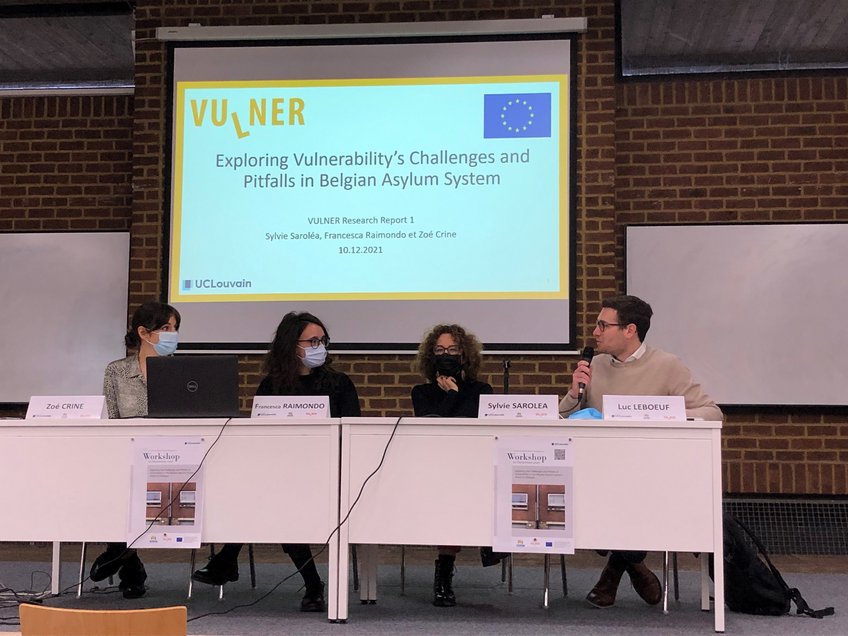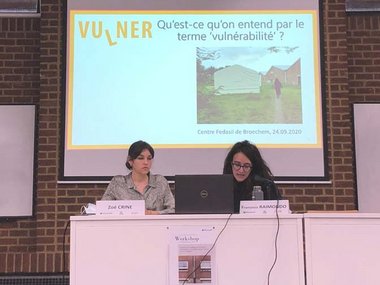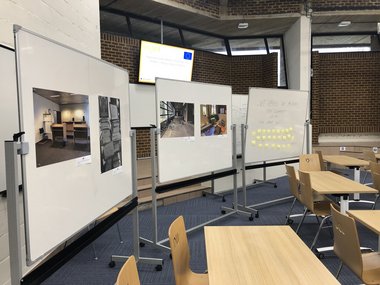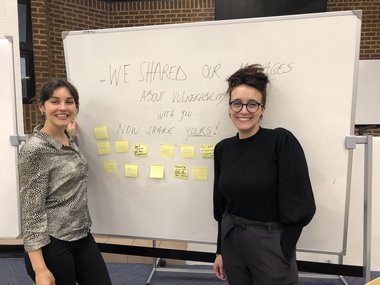Exploring the Challenges and Pitfalls of Vulnerability in the Belgian Asylum System: Actors in Dialogue
At the workshop, the VULNER Belgium team, consisting of Sylvie Saroléa, Francesca Raimondo and Zoé Crine presented their findings in the report and related policy recommendations and held an open discussion and Q&A session with Luc Leboeuf, scientific coordinator of the VULNER project and several other contributors to the project.
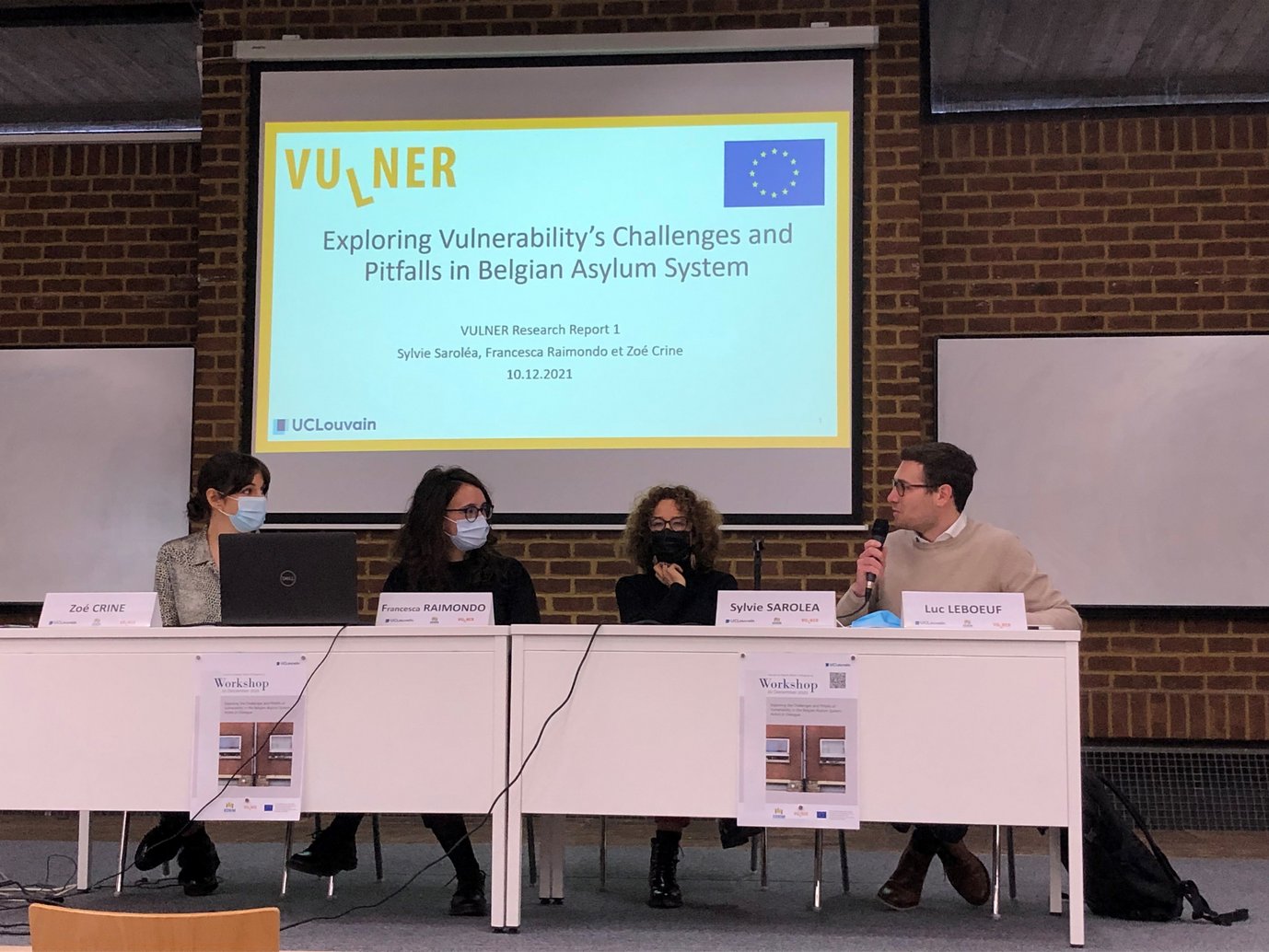
By Francesca Raimondo, VULNER (Belgium Team)
The workshop was divided into three parts: an overview of the report, two discussion roundtables and three thematic workshops.
In his welcome address, Luc Leboeuf explained that the concept of vulnerability is gaining importance in political and juridical frameworks at both the European and international levels, with variations in how the concept is applied within Europe. On one hand, there is a flexible approach that is invoked by the judges to guide the interpretation of the law in deciding a specific asylum application. On the other hand, a less flexible approach is enshrined in the CEAS (Common European Asylum System) Directives. The latter refers to the special needs of some groups on the basis of certain personal features. Lastly, he explained that the concept of vulnerability, which is a social science concept, is likely to have an inclusive effect in that field. On the contrary, when vulnerability is used within legal frameworks, it is likely to become a criterion that allows authorities to treat an asylum application differently, but with the possibility of becoming also an exclusionary concept.
Zoé Crine and Francesca Raimondo presented the report’s key findings. They began by outlining the methodology used to conduct the research. They then presented the legal and policy framework as well as the main results of the fieldwork. Their interventions were structured along the lines of meaning, content and consequences of vulnerability. More specifically, in explaining the results of their fieldwork, they examined specific vulnerable groups (connected to age, health and gender) and factors of vulnerability (migratory road, life in the reception centre, asylum procedure, education and socio-economic background). Lastly, some policy recommendations were brought to the attention of the audience: the importance of dealing with the so-called “forgotten” vulnerabilities, the necessity of making sure that vulnerability leads to actual consequences and the need to introduce adequate communication channels (e.g. the vulnerability diary).
The first roundtable was entitled ‘The Identification and Assessment of Vulnerability: Practices and Challenges’. It was chaired by Christine Flamand, member of the EDEM (Equipe droits européens et migrations) research centre, and included Julian Knittel (Deputy Director of the Red Cross reception centre of Uccle), Olivier Roisin (Judge of the Council for Alien Law Litigation, hereinafter CALL) and Elise Vanmechelen (Protection Officer at the Office of the General Commissioner for Refugees and Stateless persons, hereinafter CGRS) as speakers. Julian Knittel explained that the reception centre staff has some tools that are fundamental in the identification and assessment of the vulnerability of residents: the information that the centre eventually receives, staff observation of each resident, the so called “individual accompaniment” (a project set up in the reception centres to guarantee individual follow-ups for each resident), and the teamwork with all the professionals working in the centre (social assistant, the worker in charge of the individual accompaniment and the members of the medical office). He highlighted the following issues as key challenges in the centre’s capacity to identify vulnerabilities: the language gap between the residents and the reception centre staff, staff member training (which has not been standardized and is not grounded in a particular discipline) and the general lack of staff. Ms. Vanmechelen explained that the information in files received by the Belgian Immigration Office is a key tool used to identify and assess the vulnerability of applicants. However, she underlined that the identification of vulnerabilities is much more difficult when a disclosure of any necessary special procedural needs have not been included in the files. Finally, Oliver Roisin stressed the importance of in person hearings to help identify vulnerabilities in real time. All the speakers mentioned the importance of the communication among the different institutions, taking into due consideration the issue of confidentiality.
The second roundtable was entitled ‘The Impact of Vulnerability in the Procedure and in the Reception Centres’. It was chaired by Prof. Sylvie Saroléa, leader of the VULNER Belgian Team, and included the participants Julie Bastin (Protection Officer at CGRS), Farid Khali (Director of the Red Cross centre of Jette) and Marie Ryckaseys (Judge at the CALL). The purpose of the roundtable was to discuss if and how vulnerabilities have a concrete impact on the functioning of the asylum procedure. The debate and Q&A session mainly focused on the channels of information among the institutions, the role of the documents in the dossier of the asylum seekers (such as the medical certificates), the role of the lawyers and the importance of a specific file devoted to vulnerability.
In the afternoon session three parallel discussions were held: 1) Keeping Track of Vulnerability; 2) Vulnerability and Agency; 3) The ‘Forgotten’ Vulnerabilities.
Prof. Sylvie Saroléa chaired the first discussion group. Its objective was to debate and exchange ideas on vulnerability monitoring during the asylum process. Laura Cools, PhD Candidate at the Catholic University of Louvain, explained that the group’s discussion focused on three key problems, being: (a) the lack of communication among the different institutions involved in the asylum procedure; (b) the saturation of the asylum system; and (c) the pitfalls of the procedures that lead to the creation or the worsening of the vulnerability of the asylum seekers. On interinstitutional communication, the group agreed on the importance of ensuring that each institution fulfils their particular mandate, to avoid miscommunication and redundancy. Moreover, information must be transmitted correctly, especially in cases where there are ‘other’ vulnerabilities identified during the procedure. At the end of the discussion, they proposed that a new class of professional – the case manager – could assist with mitigating communication issues. Such case manager should be an individual independent of government, who is in charge of overseeing the entire application file and should be able to build a relationship with asylum seekers through consistent contact with such asylum seekers.
The second discussion group was chaired by Zoé Crine and had the following objectives: fostering a discussion on the findings of the report, sharing experiences on particular resilience strategies put forward by asylum seekers to cope with the procedure and thinking of how to empower asylum seekers while boosting their autonomy. Hélène Gribomont, PhD Candidate at the Catholic University of Louvain, explained that the group began its discussion analysing the concept of agency and the way this concept is used, including in a non-inclusive way (a). Participants then shared their thoughts and ideas with regard to the agency in the field of asylum as informed by the experiences gained in their work (b).
The third discussion group was chaired by Francesca Raimondo and aimed at fostering a discussion on the ‘forgotten’ vulnerabilities identified in the report, detecting further ‘forgotten’ vulnerabilities through discussion with participants and outlining different strategies to assess and address such ‘forgotten’ vulnerabilities. Alfred Ombeni, PhD Candidate at the Catholic University of Louvain, explained that three main topics were discussed: (a) the meaning of the term ‘forgotten vulnerabilities’ as informed by the diverse backgrounds and work experience of the attendees; (b) the examples of categories or factors of vulnerabilities that could be categorized as ‘forgotten’ (aside from those listed in Belgian VULNER research report); and (c) best practices for addressing these vulnerabilities. Some of the issues that were mentioned as causes of further categories or factors of vulnerability were difficulties related to cultural differences, the poor (or absence of) communication among the institutions involved in the asylum procedure and the pitfalls of the Dublin system.
Prof. Sylvie Saroléa concluded the conference by highlighting that the vulnerabilities need to be assessed and addressed at the individual level. As such, it is necessary to shift ones’ focus away from ‘the vulnerable groups’ and to ‘the vulnerable asylum seeker’. She stressed that once the individual is the focal point of analysis, they are viewed wholistically, allowing vulnerabilities and strengths to be properly understood. In addition, she underlined that vulnerability is a complex and dynamic concept whose full understanding requires several factors to be considered. She concluded by stressing that asylum seekers should not be considered as weak and desperate persons who need to be protected. Indeed, the protection given to asylum seekers should be considered as a tool to realise their full potential. In this way, they can become ‘partners’ within the country of arrival.
